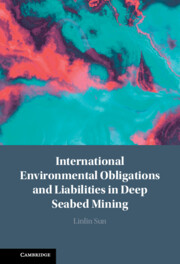Book contents
- International Environmental Obligations and Liabilities in Deep Seabed Mining
- International Environmental Obligations and Liabilities in Deep Seabed Mining
- Copyright page
- Dedication
- Contents
- Foreword
- Preface
- Acknowledgements
- Abbreviations
- 1 Introduction
- 2 Common Heritage of Mankind and Protection of the Marine Environment
- 3 International Seabed Authority and Its Environmental Mandate
- 4 International Environmental Obligations of the Sponsoring State and Contractor
- 5 Definition and Measure of Marine Environmental Damage
- 6 International Environmental Liability of the Contractor
- 7 Alternatives to International Environmental Liability of the Contractor
- 8 International Environmental Liabilities of the Sponsoring State and the International Seabed Authority
- 9 Conclusions
- Bibliography
- Index
2 - Common Heritage of Mankind and Protection of the Marine Environment
Published online by Cambridge University Press: 09 November 2023
- International Environmental Obligations and Liabilities in Deep Seabed Mining
- International Environmental Obligations and Liabilities in Deep Seabed Mining
- Copyright page
- Dedication
- Contents
- Foreword
- Preface
- Acknowledgements
- Abbreviations
- 1 Introduction
- 2 Common Heritage of Mankind and Protection of the Marine Environment
- 3 International Seabed Authority and Its Environmental Mandate
- 4 International Environmental Obligations of the Sponsoring State and Contractor
- 5 Definition and Measure of Marine Environmental Damage
- 6 International Environmental Liability of the Contractor
- 7 Alternatives to International Environmental Liability of the Contractor
- 8 International Environmental Liabilities of the Sponsoring State and the International Seabed Authority
- 9 Conclusions
- Bibliography
- Index
Summary
This chapter addresses the question of how the International Seabed Authority (ISA) discharges its environmental mandate in DSM. First, answer to this question hinges largely upon the composition, powers and functions and decision-making procedures of its organs and subsidiary bodies, in terms of both law and practice. Then, it identifies six categories of powers and obligations of the ISA relating to its environmental function. Namely, the powers to adopt rules, regulations and procedures, issue technical and administrative guidance to contractors, ensure compliance of the contractor while administering activities, issue environmental emergency order to the contractor for preventing (risk of) serious environmental damage, as well as the obligations to apply the precautionary approach, and encourage and promote marine scientific research. It argues that the ISA has changed to results-based environmental regulation. Finally, this chapter comments on the drafting work of Exploitation Regulations by the ISA and suggests ways for the LTC to assess the current state of marine scientific knowledge on a continuing basis.
Keywords
- Type
- Chapter
- Information
- Publisher: Cambridge University PressPrint publication year: 2023

